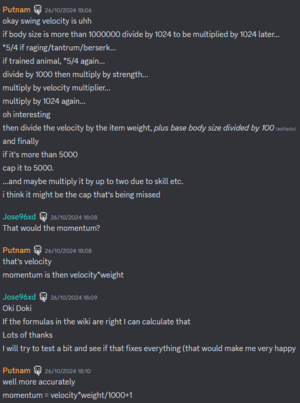- v50 information can now be added to pages in the main namespace. v0.47 information can still be found in the DF2014 namespace. See here for more details on the new versioning policy.
- Use this page to report any issues related to the migration.
Talk:Material science
Attack Momentum[edit]
Before this change the first two formulas for an average dwarf with a steel battle axe gave the same result of ~93.75, after the change the result for the 2nd formula is 367,968,750. I've checked my math with WolframAlpha here (1st formula), here (old 2nd), and here (new 2nd). The 3rd formula (added in the same edit as the 2nd) has never quite matched either of the others giving a result of ~92.86, but it's close.
I don't see the point in having the variations, but I also don't hav the technical abilities to verify if any of them are currently correct. Ziusudra (talk) 07:05, 19 August 2024 (UTC)
Attack Momentum (new formula, extra conditions and another source for the hard velocity limit of 10000)[edit]
I have been talking with Putnam recently to try to investigate the bouncing formula more. When talking with her, she ended up sharing some insight on how the momentum calculation works and some modifiers that apply to it. If I understood her correctly, "Momentum = swing_speed x weapon_wheight / 1000 + 1". I think the rest of the formulas come from here, so we may be able to unify or understand the three of them. I'm going to append here the picture of what she said, so everybody can try to understand it, and because I think there are some modifiers that aren't currently known (or at least not on this wiki page).
If my understanding of her explanation is correct: The hard cap to swing speed velocity of 10000 comes from the cap to swing speed of 5000 (when multiplied by 2 if the skill of the attacker is at least grand master I think), and there are some more swing speed modifiers (currently not mentioned in this article) that could affect the momentum of the attacks. --Jose96xd (talk) 20:11, 31 October 2024 (UTC)
Attack Momentum Costs (blunt attacks deflection/bouncing)[edit]
The bouncing/deflecting condition of blunt attacks: (2 * Sw * IYw < A * Da) where Sw is the weapon size, IYw is the weapon (material, I think) impact yield, A the contact area and Da the armor material density, doesn't take into account the weapon material density. I think this is wrong since in game the material density of the weapon affects. For example, in game, Adamantine hammers bounce and steel hammers don't while in this formula Adamantine hammers should have an easier time not bouncing due to their superior characteristics (steel has 1.5 million IY while Adamantine has 5 million). I think there is either a missing element in the formula (something related to the momentum perhaps) or there is something I'm not understanding. Jose96xd (talk) 08:55, 24 October 2024 (UTC)
- I talked with Putnam in the DF discord (I assume I understood her well, but if anyone else could please check if they understood the same, that would be fantastic). It seems the bouncing condition should use the velocity (or swing velocity) in the math (not the velocity modifier, but velocity, like "momentum=velocity*weight/1000+1"). Translating the formula (since we have the momentum and want the velocity): "velocity = (momentum-1)x1000/(weight)". This makes logical sense and would add the weapon and attacker characteristics to the math. The formula didn't match experimental data for Adamantine (average dwarfs with Adamantine hammers don't penetrate steel armor, while the formula indicated that they would). This mismatch would probably also happen with small creatures (with lower momentum) and with low density materials (i haven't tested light wood). Doing some quick math: using an average dwarf with an adamantine hammer generating 85.7 of momentum, we get a velocity of 1.058. Now, I don't know if my math is wrong, but in theory, that number should do something in the formula to allow us to accurately predict the bouncing. --Jose96xd (talk) 09:14, 27 October 2024 (UTC)
Material and item properties[edit]
There is a claim that states that "a platinum war hammer ... gets about 12% more momentum over a steel one... An adamantine hammer, however, only has 1/7th as much." There is no source for this affirmation, and I think it is wrong. In the same article, in the "Attack Momentum" section, there is a lot of calculated momentum, and the difference between a steel axe and an adamantine one is 2/3, not 1/7 (68 adamantine vs 92 steel).
Now, the affirmation was for hammers (which, for momentum, are basically half an axe) so I redid the math again, but with hammers. Results: 147 steel vs 85 adamantine. Roughly half, but way more than 1/7 of 174 (21). I think there is something wrong either with the table or with some of the formulas.
(Note: The used formula yields the same values as in the table when using axes, so I think it works fine). Jose96xd (talk) 10:04, 24 October 2024 (UTC)
What does "size" refer to in the armor size formula?[edit]
The page says:
- Armor size is calculated as underlying body part size times size multiplier where size multiplier is calculated as coverage/100% times size/100 times 1+(UPSTEP+UBSTEP+LBSTEP)/4; MAX count as 3 in the last sum.
Is this the layer_size of the piece of armor? Jecowa (talk) 06:23, 15 January 2025 (UTC)
